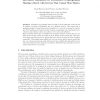Free Online Productivity Tools
i2Speak
i2Symbol
i2OCR
iTex2Img
iWeb2Print
iWeb2Shot
i2Type
iPdf2Split
iPdf2Merge
i2Bopomofo
i2Arabic
i2Style
i2Image
i2PDF
iLatex2Rtf
Sci2ools
PAIRING
2010
Springer
2010
Springer
Increased Resilience in Threshold Cryptography: Sharing a Secret with Devices That Cannot Store Shares
Threshold cryptography has been used to secure data and control access by sharing a private cryptographic key over different devices. This means that a minimum number of these devices, the threshold t + 1, need to be present to use the key. The benefits are increased security, because an adversary can compromise up to t devices, and resilience, since any subset of t + 1 devices is sufficient. Many personal devices are not suitable for threshold schemes, because they do not offer secure storage, which is needed to store shares of the private key. This article presents several protocols in which shares are stored in protected form (possibly externally). This makes them suitable for low-cost devices with a factory-embedded key, e.g., car keys and access cards. All protocols are verifiable through public broadcast, thus without private channels. In addition, distributed key generation does not require all devices to be present.
| Added | 29 Jan 2011 |
| Updated | 29 Jan 2011 |
| Type | Journal |
| Year | 2010 |
| Where | PAIRING |
| Authors | Koen Simoens, Roel Peeters, Bart Preneel |
Comments (0)

